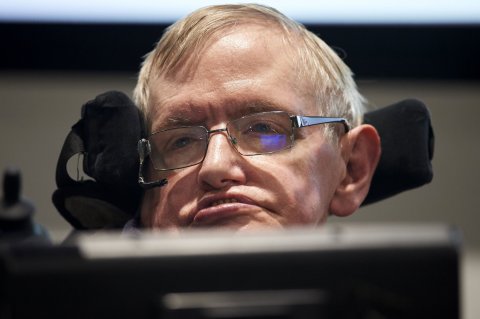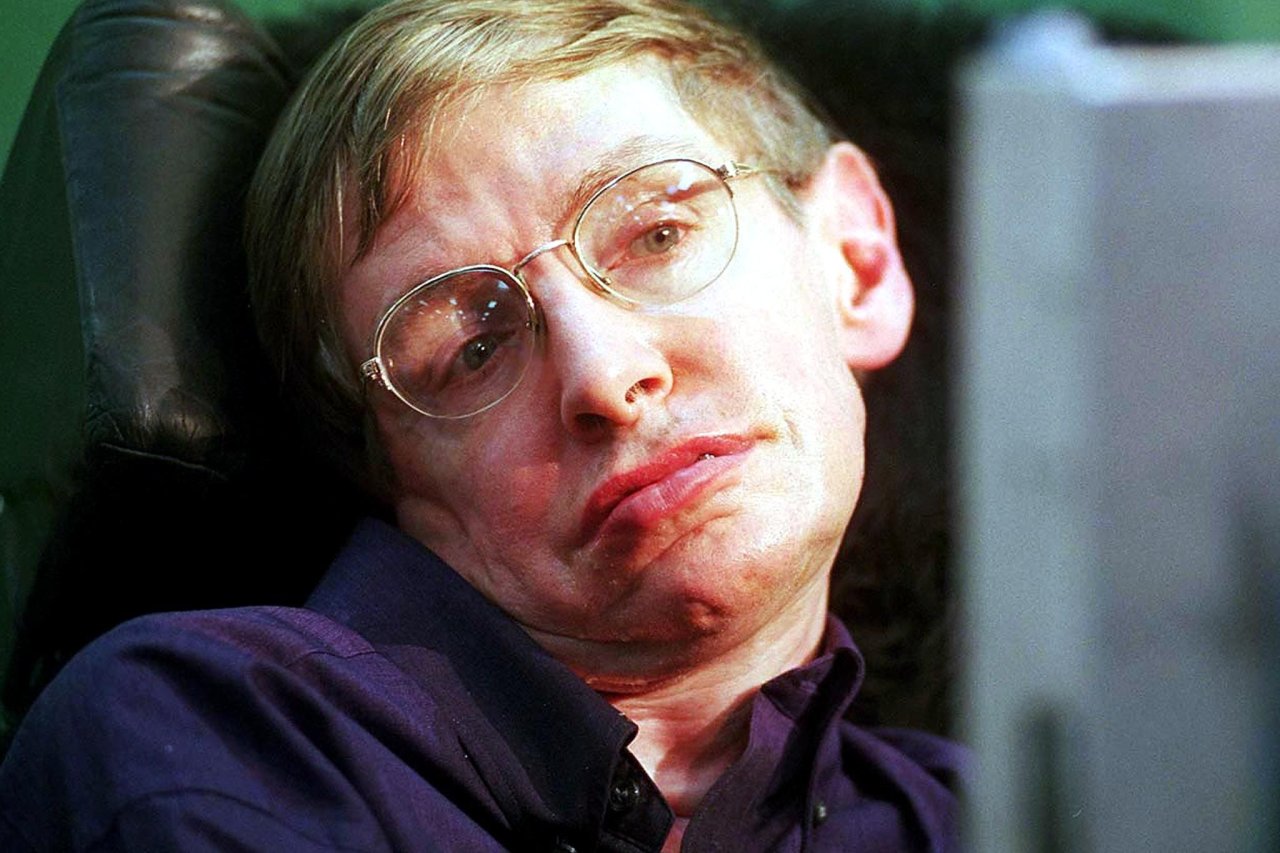Stephen Hawking, the legendary physicist, cosmologist and world-famous author, died on Wednesday at the age of 76. Here's our 1988 cover story on Hawking, published around the time his best-selling book A Brief History of Time was originally published. This piece has never been published online before now.
Like light from a collapsing star, exhausted by the struggle against gravity, the thoughts of Stephen Hawking reach us as if from a vast distance, a quantum at a time. Unable to speak, paralyzed by a progressive, incurable disease, the 46-year-old British physicist communicates with the world by a barely perceptible twitch of his fingers, generating one computer-synthesized word approximately every six seconds, consuming an entire day in composing a 10-page lecture. And the world awaits the words, for the same reason that astronomers search the heavens for the precious photons from remote galaxies, or that Newton spent his last years consumed by Biblical prophecy: Hawking is trying to read the mind of God.
He believes he is as close as man has ever come. It is difficult, of course, to assess the career of a great scientist while he is still relatively young and productive, but Hawking is not above giving us some hints. The jacket copy on his best-selling survey of modern cosmology, A Brief History of Time, observes that Hawking "was born on the anniversary of Galileo's death, holds Newton's chair as Lucasian Professor of Mathematics at Cambridge University and is widely regarded as the most brilliant theoretical physicist since Einstein." So that no one misses the point, Hawking wrote an appendix consisting of brief biographical essays on these three, each beyond a doubt the greatest scientist of his era. He is obsessed with their hardships: Einstein's persecution as a pacifist and a Jew, Galileo's heresy trial, Newton's campaign to keep Leibniz from grabbing the credit for inventing calculus. All together, of course, those difficulties don't measure up to Hawking's 26-year losing battle with amyotrophic lateral sclerosis, better known as Lou Gehrig's disease. Hawking, who is known to have a sense of humor about himself, might appreciate the irony that he managed to contract not just any terminal illness but one named after the greatest first baseman of his age.
Specifically, Hawking is one of a number of scientists searching for the magnificently named Grand Unification, a theory linking the two greatest intellectual achievements of the 20th century, relativity and quantum mechanics. The former deals with the large-scale structure of the universe, as determined essentially by gravity; the latter is concerned with the forces that operate at the atomic scale and below. Reconciling these two theories, a goal that eluded even Einstein, might hold the key to understanding how the universe came into being. A grand unification theory would deserve not just a Nobel Prize but the last Nobel Prize; as Hawking puts it, "There would still be lots to do [in physics], but it would be like mountaineering after Everest."
Necessarily, Hawking pursues these questions on a purely cerebral level. But also by choice: He is a theoretical physicist, a discipline that in recent years has far outstripped the ability of scientists to make observations. In his book Hawking quotes a description applied to the great theoretical physicist Wolfgang Pauli, of whom it was said that "even his presence in the same town would make experiments go wrong." But, after all, experimenters deal in mere data; it would be a puny sort of God who lets himself be seen in a radio telescope or trapped in a particle accelerator. Hawking prefers to stalk him on what he considers the higher plane of human intellect, armed only with the language he is confident they both speak, mathematics.
Hawking's most famous work has been on the nature of black holes. These are regions of extremely dense matter in which gravity is so strong that nothing, not even light, can escape. Astrophysicists believe a black hole might form when a burned-out star collapses. Surrounding a black hole is a surface known as the event horizon, a kind of trapdoor through which matter could pass in only one direction—inward—sealing off the hole from the rest of the universe. The existence of black holes was first posited in the 18th century (by a Cambridge don, Hawking notes smugly). They have been written about and studied and cited so often that it comes as a bit of a shock when Hawking observes that there is still no conclusive physical evidence that they exist. Hawking has a wager riding on the question with the physicist Kip Thorne at Caltech. Hawking bet against the existence of black holes; if he wins, much of his life's work will be wasted, but he will get a four-year subscription to Private Eye, a British satirical magazine. If black holes do exist, Thorne gets a year of Penthouse and, conceivably, Hawking gets the Nobel Prize.
In 1974, at a conference near Oxford, Hawking set out to show that it was possible for black holes to emit radiation. His calculations were based on the principle of quantum mechanics that at the subatomic level particles do not obey the same laws that we see in material objects around us. They lead a strange kind of contingent existence, in which their position and momentum are usually uncertain, subject to random fluctuations over infinitesimal fractions of a second. Particles can even be created out of empty space—with the proviso that they are created in pairs of "virtual particles" that must instantly collide and annihilate one another. What would happen if such a pair were to come into existence right at the event horizon? Hawking demonstrated that it was possible for one of the particles to be sucked into the black hole and the other to escape into space. This was such a revolutionary assertion that the chairman of the conference stood up to denounce it on the spot, but it has gained considerable acceptance since then, and the radiation that would result from this process has come to be called Hawking radiation. Of course, no one has ever found it in nature, either. The real significance of Hawking's paper was that it married quantum mechanics—the source of virtual particles—to relativity, the theory that predicts black holes. He had taken the first step on the road to a Grand Unification.
Legendary Courage
A step on the road: It is instructive to realize how inadequate even simple metaphors are in dealing with someone like Hawking. He can't take a step any longer, but his courage in facing his affliction is legendary. His collaborator on black-hole theory, the great Oxford physicist Roger Penrose, remembers visiting Hawking when he could still maneuver on crutches, and watching him spend a quarter of an hour going up the steps to bed, declining all help. Even now he travels the world extensively, attended by three nurses working round-the-clock shifts and by graduate student Nick Phillips, who looks after his elaborate array of computerized communications gear. Just this past spring Hawking visited California, recalls Berkeley cosmologist Joseph Silk, "going up and down the state, giving more than a dozen talks, on a schedule that any fit person would find exhausting."
He was not always such a paradigm of energy. As an undergraduate at Oxford, he worked just hard enough to let his professors know how brilliant he was. He was the sort of student, recalls his physics tutor, Pat Sandards, who preferred picking out the mistakes in his textbooks to doing the problems at the end of the chapter. For the next couple of years, which he spent at Cambridge, he barely bothered even to do that. Symptoms that he had first noted at Oxford—slurred speech, difficulty tying his shoes—had become worse, and doctors told him he had what the English call motor neuron disease. His time was spent in his room listening to Wagner, reading science fiction—and drinking. There was another problem as well, recalls Dennis Sciama, who supervised Hawking's graduate work: "There weren't a lot of problems lying around suitable for someone of his ability." When he finally found one, in a paper by Penrose on black holes, things began to change quickly. He began working hard for the first time in his life, the progress of his disease inexplicably slowed—and he fell in love with a language student named Jane Wilde. They were married in 1965 and they now have three children, two boys and a girl, the youngest born in 1979. Through disease and the potentially more distracting peril of fame, Hawking has managed to maintain a decent, happy family life. "Stephen doesn't make any concessions to his illness, and I don't make any concessions to him," Jane has said.

Taking Tea
For a successor to the mantle of Newton and Einstein, Hawking seems not to rate many perks. His office is in a narrow, cluttered cubicle in the Department of Applied Mathematics and Theoretical Physics, which occupies a building as charmless and functional as its name. He spends his days there writing, seeing students or taking tea with them in the drab common room. He usually rolls up in his motorized wheelchair, which he steers with a joy stick on the half-mile ride from home in late morning, and works until around 7 in the evening. On a typical Friday last month, he began his day at the lunchtime meeting of a relativity seminar he leads. Two dozen students filled the room, sharing boxes of cookies and packages of luncheon meat, as Hawking wheeled quietly in and surveyed the scene.
His fingers twitched and the screen mounted on his wheelchair flickered. "Like old times," came a metallic voice from a speaker behind his seat.
Hawking's computers are cleverly designed for someone who can make only one movement. On the screen before him, the cursor flicks among letters of the alphabet, stopping at one when he squeezes the switch; this calls up a screen full of pre-programmed words beginning with the chosen letter. There are 2,600 such words, mingling the esoteric language of his field with the mundane nouns a man needs to get around in the world—thermal, theory, topology; thanks, Thursday, tea. The cursor scrolls down the lists until Hawking makes his choice, and the word is added to a sentence at the bottom of the screen, ready to be pronounced—or, in a formal interview, displayed on a desk monitor for precise note-taking. He can also spell out new words, which he does with no shortcuts or abbreviations. Anyone trying to finish his sentences for him feels the silent scorn of that imperturbably flicking finger.
Related: Stephen Hawking tried to prove time travel with a party 'held in the past'
The seminar consisted of a research fellow, Peter Ruback, reading a paper on "New Uniqueness Theorems for Charged Black Holes." As Ruback filled the blackboards with equations, Hawking watched, swallowing a few forkfuls of lunch fed to him by his nurse. At the end of an hour and a half, there was a brief burst of applause, followed by silence, and Hawking's ominous clicking. "I would be interested if you could find a different wormhole," came the voice, "—with a different topology."
Asked later what he thought of Hawking's reaction, Ruback shrugged: "I think he thought it was rather obvious—which it may be, to him."
Self-Righteous
To anyone dependent on Hawking's approval, his handicap can be maddening, because his synthetic voice is completely devoid of expression and his one change of facial expression—a slightly slack-jawed grin—serves for a wide variety of emotions. His terse remarks take on an oracular quality that can preclude disagreement. "Students have to take what he says and go away and figure it out," Penrose observes. He recalls one heroic three-day argument over black holes that was never fully resolved: "If [Hawking] wanted to speak, he made a noise. I would have to stop and listen and I'd lose the train of my argument. It was very frustrating."
And there is a self-righteous streak in Hawking that some colleagues find nettlesome. In his book, he recounts discussing an unpublished theory of the Russian physicist Andrei Linde at a lecture in Philadelphia in 1981. Paul Steinhardt, a young assistant professor at the University of Pennsylvania, was in the audience and later published a paper, with Andreas Albrecht, proposing "something very similar to Linde's idea . . . ," Hawking wrote. He added, "[Steinhardt] later told me he didn't remember me describing Linde's ideas . . . " The implications of a remark like this, from a world-famous scientist about a lesser-known colleague, can be devastating. Steinhardt—who says he had already corrected Hawking on the point—was disturbed enough when the story reappeared in the book to dig up a videotape of Hawking's lecture, which he says supports his assertion that Hawking never mentioned Linde's work. "Hawking is an outstanding physicist," said Steinhardt, "but he's not a god, he's a human being." Steinhardt sent the tape to Hawking, and—after Newsweek raised the question—Hawking announced, through his U.S. publisher, that the account will be expunged from future editions.
To be sure, Hawking wasn't seeking credit for himself but for his friend Linde. And, already living on borrowed time, he can perhaps be forgiven for his impatience in correcting what he sees as injustice. Has a similar attitude of impatience affected his scientific work? Penrose believes that Hawking's condition has forced him to work more creatively, to take imaginative leaps where someone with a less uncertain future might want to cogitate a little longer. Hawking himself dismisses that notion utterly. The only effect of ALS on his work he is willing to concede is that "I avoid problems with a lot of equations, because I cannot manage to do them in my head. But," he adds, "those are the most boring problems."

There is really only one interesting problem, which is the problem of everything. "My goal," Hawking has said, "is a complete understanding of the universe, why it is as it is and why it exists at all." And slowly, painfully, he has advanced on that goal. The journey has taken some surprising turns. Hawking, together with Penrose, was a leader in postulating a property of black holes known as singularities. As predicted by relativity, these are points at which matter is not merely tremendously dense but infinitely dense—the remnants of a star collapsed to a point of zero size. Since the laws of physics, in their mathematical expression, cannot accommodate infinite quantities, the logical conclusion was that these laws no longer apply at a singularity—and literally anything can happen. (We never see the laws break down because it happens inside the event horizon, from which nothing can escape.) The universe, according to some models, began with a singularity, which erupted into the Big Bang. Many physicists are satisfied with some version of this account. But Hawking realized you could never completely understand a universe that began at a point where anything could happen.
Imaginary Time
His journey, therefore, has taken him away from singularities, toward a theory that modifies the stark predictions of relativity through the application of quantum mechanics. He achieved this result in a totally abstract and mathematical form, by postulating a different kind of time, "imaginary" time as distinct from the "real" time that measures our days and years. ("Imaginary" is used here in a technical mathematical sense—meaning the square root of a negative number—it does not have its common-sense meaning of "illusory." And it is impossible to discuss it in ordinary physical terms; the question "How long is an imaginary year?" is meaningless.) In imaginary time, there are no singularities; the universe is finite, but without the boundaries that singularities imply, in the way the surface of the earth is finite but unbounded. In an hourlong interview, Hawking rises to the level of a paragraph on only one subject, this "no-boundary proposal": "I think that it really underlies science because it is really the statement that the laws of science hold everywhere. Once you allow that there could be exceptions to the laws of science, you couldn't predict anything . . . If the laws of science broke down the beginning of the universe, they could break down anywhere."
And is this, then, the key that will unlock the true secret of the universe? The next two decades, Hawking has said, should hold the answer. Project Hawking's intellectual growth over the next 20 years and the possibilities are almost limitless; do the same with his physical deterioration and . . . There is a phenomenon of relativity known as time dilation, in which time appears to slow down almost to a stop for bodies that approach the speed of light. Hawking alludes, in his book, to what it might be like for an astronaut as he accelerates toward a black hole, as all eternity passes by outside in an instant of his time. There is a sense in which Hawking himself has experienced a kind of time dilation, an inexplicable slowing of a natural process that has added decades to his expected life span. The answer he seeks may be almost within his sight. But so, perhaps, is the event horizon.
This story originally appeared in the June 13, 1988, issue of Newsweek, with the headline "Reading God's Mind." Written by Jerry Adler, with Gerald C. Lubenow in Cambridge and Maggie Malone in New York.













